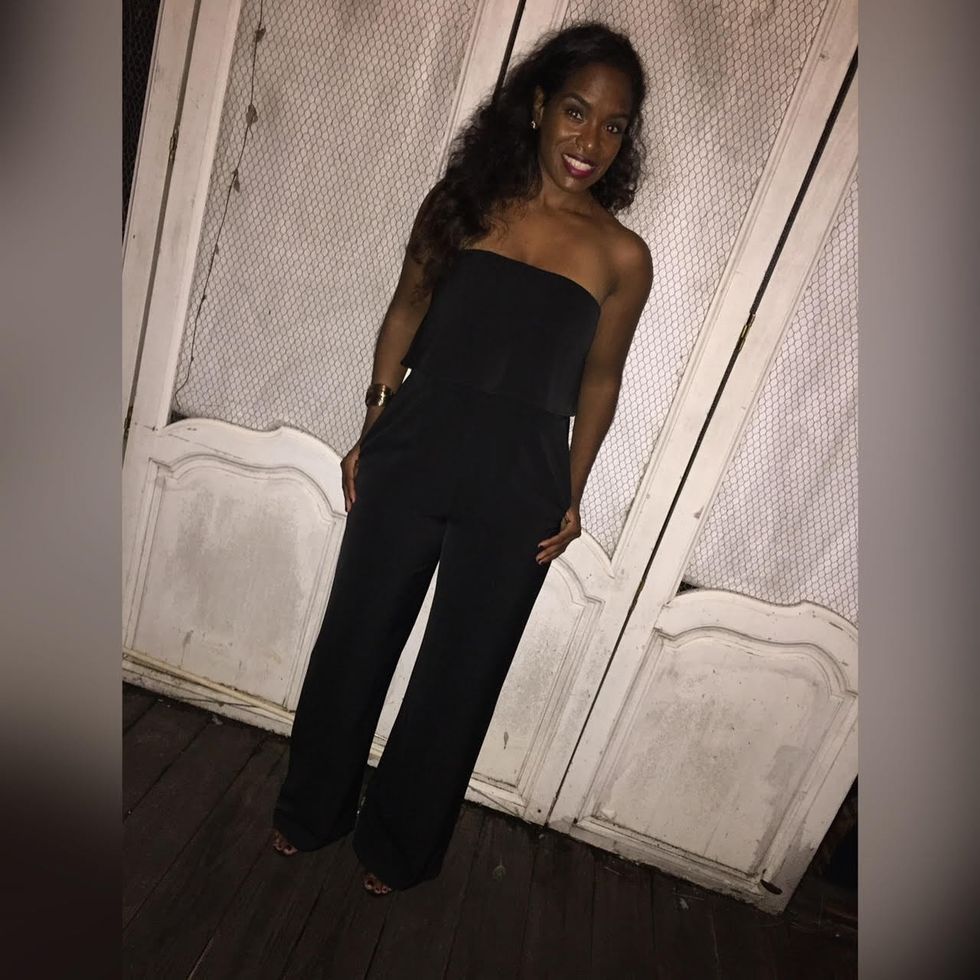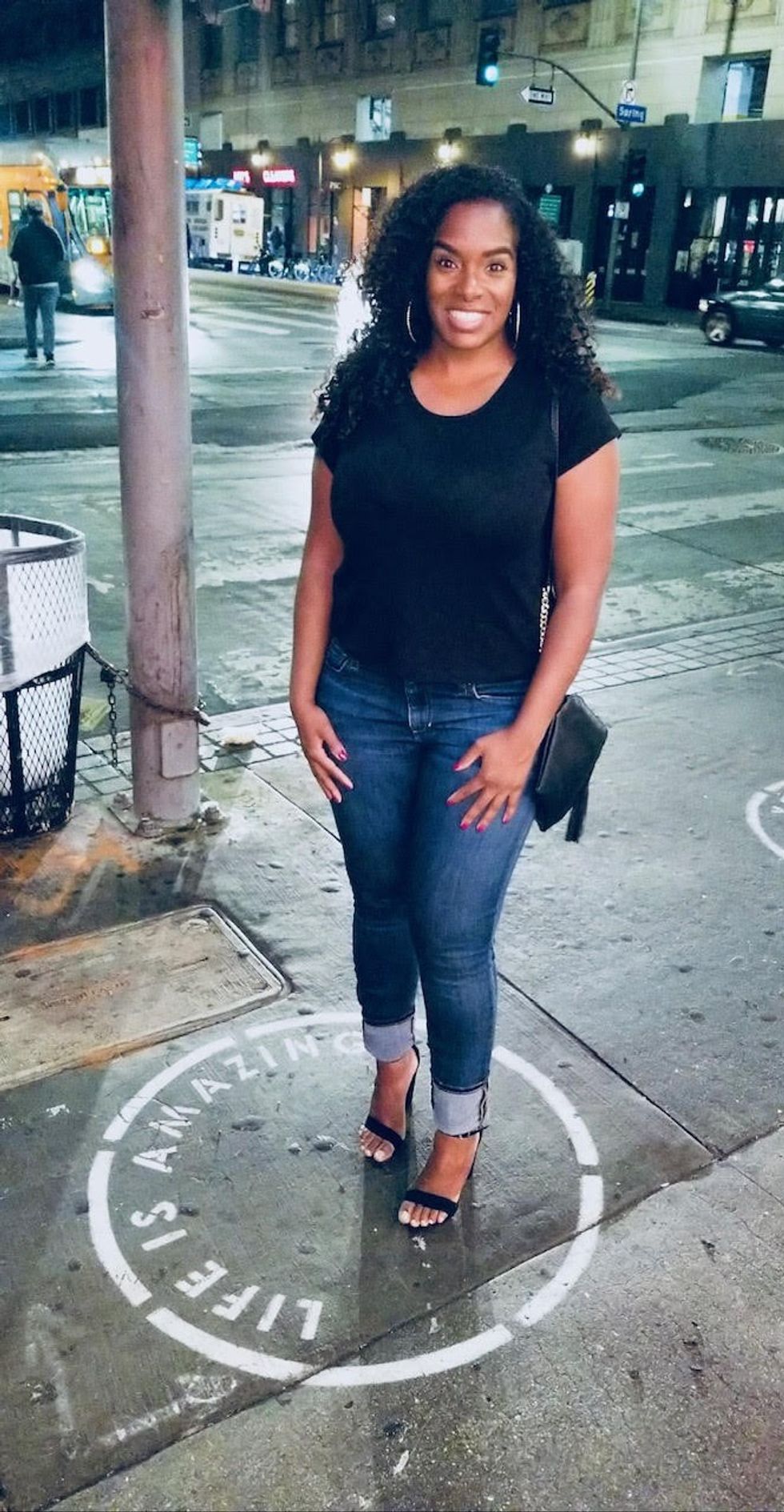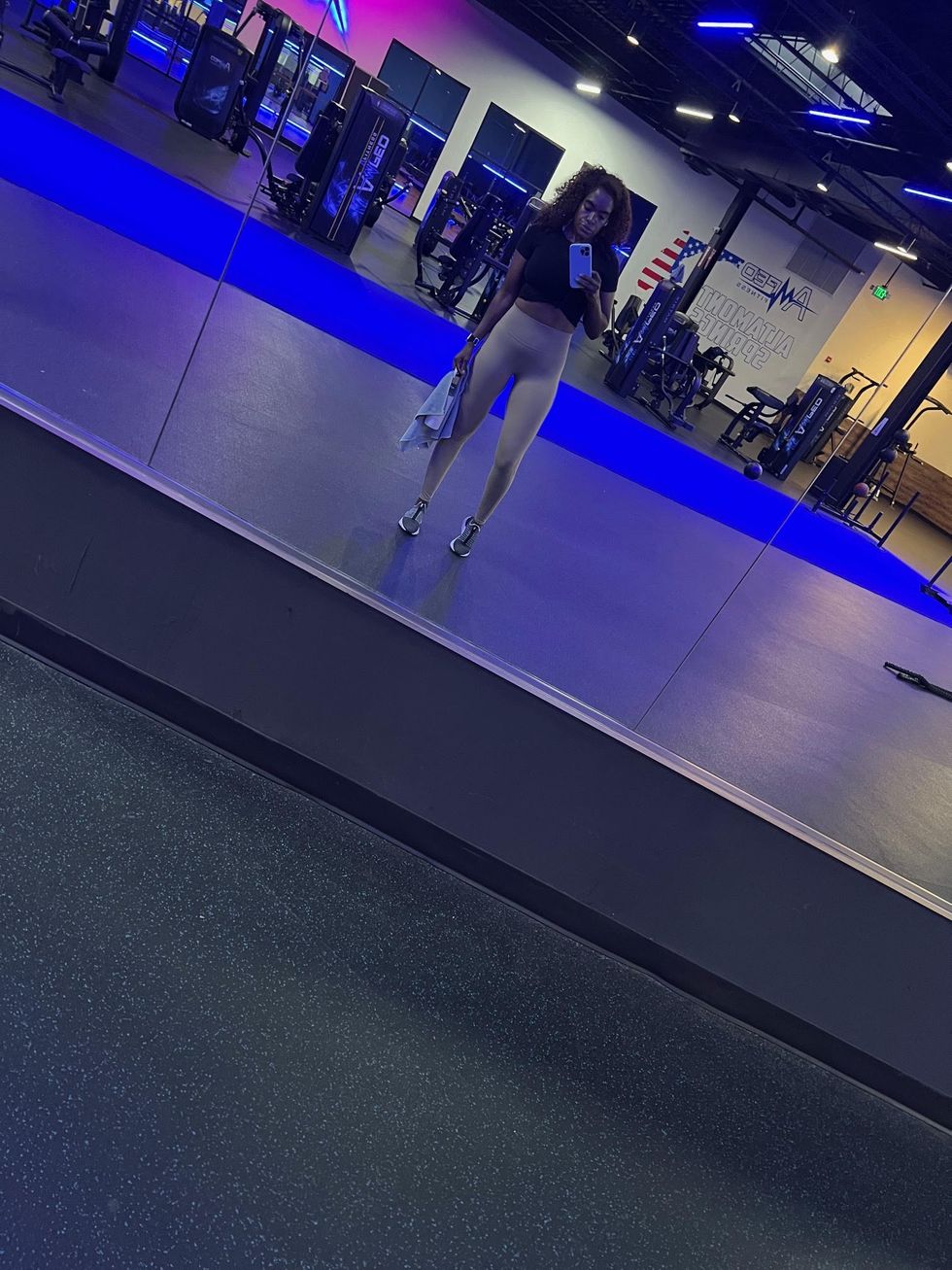Here's Why I Don’t Feel A Way About Using A Weight Loss Drug To Heal My Body

By now, you have all heard of Ozempic, Wegovy, Mounjaro, and Zepbound. These are the newest drugs on the market prescribed for weight loss and obesity. Deemed as the "cheat code" for summer body goals, celebrities like Oprah Winfrey, Al Roker, Whoopi Goldberg, Amy Schumer, Tracey Morgan, Elon Musk, and Chelsea Handler have gone public about their use of the medication to aid in their weight loss journeys. And their results are giving. I mean, have you seen Oprah lately? The woman is 70 years old, and she is serving and giving it all.
Before these drugs were reclassified as weight loss medications by the FDA, these GLP-1 drugs hit the pharmaceutical market solely as a diabetes medication. The side effect of the drug is suppressed hunger and reduced “food noise.” These medications help overweight and/or obese patients successfully lose 25% of their body weight or more. Continuous debates on social media and news outlets are trending on the success of the drug in the fight against obesity, but also on the medical dangers and long-term side effects of using these drugs.
Nonetheless, the demand for these weight loss drugs continues to skyrocket, creating mass shortages from manufacturers Eli Lilly and Novo Nordisk.
The demand for these types of medication has created an unprecedented effect when it comes to access for patients with a medical diagnosis or not. Health insurance providers only cover the drug with a diabetes diagnosis or through an authorization process, thus creating an expensive out-of-pocket cost to patients. The cost of these medications is not cheap. Any variation of these GLP-1 drugs ranges from $1000-$1,500 per monthly supply.
Times that by three, six, or nine months – that is the equivalent of a luxurious international vacation or a down payment for a new car. Primary care physicians and medical specialists are writing prescriptions with no hesitation. And patients are willing to pay whether it is a medical necessity or not.
My truth: I am a 39-year-old woman who was previously 49 pounds overweight. I was prescribed a GLP-1 medication to heal my body, and I feel no type of way about it.
But before I share my story and justify my reasoning for using a weight loss medication, let’s first examine the facts to provide perspective and understand the underlying causes of weight gain because no two individuals's health and wellness journeys are identical.

2015 - the last time I was 135 pounds
Courtesy of the writer
The Weight Loss Drugs Facts Presented By Oprah
On March 18, 2024, ABC Network aired An Oprah Special: Shame, Blame, and the Weight Loss Revolution. The purpose of the interview is to release the stigma, shame, and judgment for individuals who are overweight and how they choose to lose or not lose weight. The interview provides a 360-view of the biology of obesity, the use of weight loss medication, and the pharmaceutical industry. Invited to the conversation are users of the drug, medical specialists, representatives from the manufacturing companies of the medications, and the CEO of Weight Watchers.
The audience is comprised of current and past users of a GLP-1 or semaglutide medication. Oprah begins her interview special by openly discussing her struggle with her own weight. She states, “For 25 years making fun of my weight was a national sport.” In 1990, TV Guide referred to Oprah as “bumpy, lumpy, and downright dumpy.” Oprah also openly admits she starved herself for five months to lose 67 pounds on a liquid diet, which she gained back in less than days.
What The Experts Say About Obesity
Oprah states that the American Medical Association defined obesity as a chronic disease 10 years ago. Dr. W. Scott Butsch, Director of the Obesity Medicine in the Bariatric and Metabolic Institute at the Cleveland Clinic shares in the interview that obesity is a complex disease. Think about genetics, environments, food, sleep patterns, and microbiome changes. He states that it is the brain that controls body fat, food intake, and metabolism.
Obesity is defined as dysfunction of the regulatory system – when you lose weight, it intentionally slows your metabolism down, and your body is built to maintain your weight. Dr. Butsch continues to explain that some people are prone to hold on to their body fat. Therefore, it is wrong to shame people about obesity as they are subtypes of the disease in the obesity spectrum.

2018 - probably 160-175 lbs.
Courtesy of the writer
Types Of Weight Loss Drugs
Dr. Amanda Velasquez, Assistant Professor of Cedars-Sinai Surgery and Director of Obesity Medicine & Center of Metabolic Health states to date there are seven medications available to treat obesity, including glucagon-like-peptide 1 hormone (GLP-1s). This hormone is produced by the gastrointestinal organ and GLP-1s mimic what the hormone does and does it better. This means reducing food noise, feeling satiety faster, and slowing digestion. For people who are living with obesity, their GLP-1 hormone isn’t working properly. With that said, the medication reprograms the gastrointestinal organ.
Data does show that obesity patients would have to be on medications for the rest of their lives as the disease does not stay in remission. However, Oprah maintains her weight by hiking, walking, running, weight training, and a healthy diet. It is important to note that the Food and Drug Administration (FDA) approved drugs like Ozempic 20 years ago for type II diabetes. Dr. Velasquez further states the side effects of choosing not to take the medications are higher than the mild side effects of nausea and vomiting – obesity is a disease, not a character flaw.
Weight Loss Issues

2021- 170-180 lbs
Courtesy of the writer
Now that we are clear on the biology of obesity, let’s get into my weight issues. I was born 0.9 pounds as a premature twin baby. I graduated high school at 115 pounds, graduated college at 125 pounds, and graduate school at 128 pounds. Given these numbers, you can see I was never a heavy-set person. Picture runway model skinny with tig ol’ bitties. Yes, that was me. It wasn’t until I transitioned into a high-stress career that my lifestyle habits began to change. I began to gain some weight. I went from 135 pounds in 2016 to 150-something pounds in 2017.
At the time some of my friends would say, “I look healthy” or “you look good” given I was in my early thirties. Now, combine a high-stress career with mental health issues, emotional trauma, and a worldwide pandemic together. Add 32 more pounds to the weight I previously gained – your girl is now THICC at 182 pounds. Even though I carried this new weight well, it was too much for my height of 5 '4 and small frame. Not only did I know this, but I felt it too. It was the way my clothes slowly stopped fitting me and the heavy breathing. It’s true – the body really does keep the score.
Returning To A Healthy Lifestyle & A Medical Diagnosis

March 2023- 150 lbs
Courtesy of the writer
In 2019, I left my corporate career which eliminated my main source of stress. As the pandemic came to an end in 2021, fitness clubs fully reopened. I returned to the gym and my healthy lifestyle habits seamlessly. Please note I have always been a gym-goer or someone who enjoyed working out and eating healthy since 2011. I went back to my normal workout routine – running, climbing the stair mill, lifting weights on my own, and enlisted the help of a personal trainer twice a week.
It wasn’t until January 2022 that I noticed that the weight was not moving despite my clean eating and disciplined efforts.
In February 2022, I decided to seek medical assistance from my primary care physician, gynecologist, endocrinologist, and holistic/functional medicine doctor. It took a whole eight months before I received a proper medical diagnosis and clarity as to why my body was not responding to my normal weight loss efforts.
The answer was rooted in trauma and a hormonal imbalance, which gave me an autoimmune disease – Hashimoto Thyroiditis.
A Heavy Decision

June 2023- 133 lbs
Courtesy of the writer
It was September 2022 when I decided to pursue functional medicine to heal my body. I detoxed for 8 months with Chinese herbs, a paleo diet, and daily workouts. And it was the end of October 2022 when my endocrinologist said to me, “I am going to help you.” He said, “Have you heard of Eli Lilly?” I replied, “No.” My endocrinologist went on to explain that Eli Lilly manufactures the newest diabetes drug Mounjaro. A medication that beat clinical trials against Ozempic and Wegovy.
This new medication helps patients lower their A1C, and glucose, promotes insulin sensitivity, and helps patients lose 25% of their body weight. Keep in mind this was my first time hearing about medications for weight loss in general. I never had to be on medication for anything in my life outside the normal cold, sinus infection, flu, birth control, and hormonal acne.
The idea of prescribed medication to lose weight sounded absurd.
We are constantly told by the fitness industry to eat clean, eat our macros, stay in a caloric deficit, and work out. However, the body is complex – what they don’t tell women is that the problem is very much hormonal, and a holistic approach is required. At first, I was against using the medication because I did feel like it was cheating. I felt a sense of shame and anxiety too. “What are my family and friends going to say?” was my first thought.
I am the type of person who believes in discipline, consistency, hard work, and making the right decisions always gets you where you need to be. BUT, what my endocrinologist explained to me was that my body stopped responding due to my hormonal imbalance. He further explained that Mounjaro will stimulate my insulin (FYI insulin is a hormone) to function properly so that my body can naturally lose and/or maintain weight.
What I needed was what my endocrinologist referred to as a metabolic reset. This is achieved by losing 25% percent or more of my body weight. I had waited a good three months to secure an appointment with this man. And he wasn’t just any endocrinologist – he was the director of an endocrinology and diabetes institute. So, I decided to appease him and told him to “write the script.”
The Journey To Healing My Body

Currently 137 lbs
Courtesy of the writer
After I was prescribed Mounjaro and before I administered my first dose, I went down the rabbit hole of looking at TikTok videos from users who were prescribed a GLP-1. I wanted to listen to their reviews, success stories, and experiences with the side effects. I wanted to see what their diets looked like and if they gained any weight after coming off the medication. What I found was that most people did lose the weight they needed to. I also found that women who have insulin resistance (my initial diagnosis) and polycystic ovarian syndrome (PCOS) were using GLP-1 medications too. They were also successful in achieving a healthier weight.
There were a few TikTok users who reported experiencing the known side effects of nausea, vomiting, bowel changes, and loss of appetite. When it came to diet, I noticed that either these people were not eating clean, unprocessed foods or they were barely eating at all. A lot of the content found on TikTok when it comes to diet was packaged, processed foods or fast food (i.e. Chipotle or Chick-fil-A salad). As for exercise, there were some people that worked out daily and others that did not.
With that said, my approach to using Mounjaro was completely different. I know myself, and my goal was to be healthy regardless of choices and sacrifices I had to make. I wasn’t interested in instant gratification, I was interested in longevity and sustainability.
Having started a holistic detox, I had previously adopted a paleo diet in conjunction with the medication. Organic meat, fish, vegetables, and fruit. I started to read food labels and if it had some long scientific ingredients – I wasn’t buying it. I also eliminated soy, dairy, sugar, caffeine, gluten, alcohol, white carbs, legumes, and inflammatory oils (seed and vegetable oils). I continued my daily workouts five times a week, controlled my stress, and adopted a new sleep routine.
Come November 2022, I injected my first dose of Mounjaro into my belly. I did experience changes in my bowels for one week as my body adjusted to the medication. It wasn’t enjoyable, but I survived.
I think I vomited a total of two times but I cannot confirm if it was a reaction to the detox phase I was in or the medication. By the end of December 2022, I had lost 15 pounds and by the end of February 2023, I had lost an additional 13 pounds. I continued to stay disciplined and consistent with everything I was doing. I was motivated by the results, more so because the medication wasn’t cheap and neither was the holistic detox.
By May 2023 I had achieved a metabolic reset by losing 25% of my body weight. My bloodwork showed an insulin level of below ten. The endocrinologist said going forward metabolic indicators are how flat my stomach is. Pay attention to my sugar and salt cravings – not the number on the scale.
Let me tell you my stomach is flatter than it used to be and I don’t crave any sugar or salt.

Courtesy of the writer
May 2024 will make it one year since I am Mounjaro free. And guess what? I have maintained my weight by strictly adhering to my paleo diet, lifestyle habits, and gym routine.
In May 2023, my weight was 137 pounds; in December 2023, I weighed 134 pounds. As of today, I currently weigh 137 pounds. I have achieved an insulin level (3.5) of a pro-athlete, which shocked my endocrinologist. In eight months, I will be 40 years old. I can run a mile in under nine minutes and three miles in under 35 minutes, and I lift moderately heavy for a girl.
I have no regrets about using a weight loss medication to heal my body nor do I feel any shame around my decision. My medical issues and circumstances are unique to me. I didn’t do anything different other than advocate for my health, seek the right answers, and execute accordingly.
For me, it is very rewarding to know that I am in good health thus far and the lab work shows. I am so grateful to have the information and resources accessible to me so that I could heal my body.
My physical transformation wasn’t just about losing weight – it was about getting back to myself. For years, all I wanted was to get me back. And that’s exactly what I went and did. I would say when it comes to navigating the decision to use weight loss medications to heal your body – listen to yourself first.
It’s okay to ask for help from your doctor – especially when it’s deemed medically necessary or if your body isn’t functioning properly. It’s not just about how you look and feel but it’s also about your general health too. Good health surpasses any negative opinions formed against you.
Let’s make things inbox official! Sign up for the xoNecole newsletter for daily love, wellness, career, and exclusive content delivered straight to your inbox.
Feature image courtesy
- Ayesha Curry Lost 35 Pounds Since January. Here's How She Did It. ›
- Here's What Issa Rae Did To Lose Her "New Money Weight" ›
- Lizzo Shares Her Views On The Evolution Of 'Body Positivity' Amid Weight Loss Journey ›
- The Truth About Medical Weight Loss Clinics: Do Diet Pills Actually Work? ›
Exclusive: Viral It Girl Kayla Nicole Is Reclaiming The Mic—And The Narrative
It’s nice to have a podcast when you’re constantly trending online. One week after setting timelines ablaze on Halloween, Kayla Nicole released an episode of her Dear Media pop culture podcast, The Pre-Game, where she took listeners behind the scenes of her viral costume.
The 34-year-old had been torn between dressing up as Beyoncé or Toni Braxton, she says in the episode. She couldn’t decide which version of Bey she’d be, though. Two days before the holiday, she locked in her choice, filming a short recreation of Braxton’s “He Wasn’t Man Enough for Me” music video that has since garnered nearly 6.5M views on TikTok.
Kayla Nicole says she wore a dress that was once worn by Braxton herself for the Halloween costume. “It’s not a secret Toni is more on the petite side. I’m obsessed with all 5’2” of her,” she tells xoNecole via email. “But I’m 5’10'' and not missing any meals, honey, so to my surprise, when I got the dress and it actually fit, I knew it was destiny.”
The episode was the perfect way for the multihyphenate to take control of her own narrative. By addressing the viral moment on her own platform, she was able to stir the conversation and keep the focus on her adoration for Braxton, an artist she says she grew up listening to and who still makes her most-played playlist every year. Elsewhere, she likely would’ve received questions about whether or not the costume was a subliminal aimed at her ex-boyfriend and his pop star fiancée. “I think that people will try to project their own narratives, right?” she said, hinting at this in the episode. “But, for me personally – I think it’s very important to say this in this moment – I’m not in the business of tearing other women down. I’m in the business of celebrating them.”
Kayla Nicole is among xoNecole’s It Girl 100 Class of 2025, powered by SheaMoisture, recognized in the Viral Voices category for her work in media and the trends she sets on our timelines, all while prioritizing her own mental and physical health. As she puts it: “Yes, I’m curating conversations on my podcast The Pre-Game, and cultivating community with my wellness brand Tribe Therepē.”
Despite being the frequent topic of conversation online, Kayla Nicole says she’s learning to take advantage of her growing social media platform without becoming consumed by it. “I refuse to let the internet consume me. It’s supposed to be a resource and tool for connection, so if it becomes anything beyond that I will log out,” she says.
On The Pre-Game, which launched earlier this year, she has positioned herself as listeners “homegirl.” “There’s definitely a delicate dance between being genuine and oversharing, and I’ve had to learn that the hard way. Now I share from a place of reflection, not reaction,” she says. “If it can help someone feel seen or less alone, I’ll talk about it within reason. But I’ve certainly learned to protect parts of my life that I cherish most. I share what serves connection but doesn’t cost me peace.
"I refuse to let the internet consume me. It’s supposed to be a resource and tool for connection, so if it becomes anything beyond that I will log out."

Credit: Malcolm Roberson
Throughout each episode, she sips a cocktail and addresses trending topics (even when they involve herself). It’s a platform the Pepperdine University alumnus has been preparing to have since she graduated with a degree in broadcast journalism, with a concentration in political science.
“I just knew I was going to end up on a local news network at the head anchor table, breaking high speed chases, and tossing it to the weather girl,” she says. Instead, she ended up working as an assistant at TMZ before covering sports as a freelance reporter. (She’s said she didn’t work for ESPN, despite previous reports saying otherwise.) The Pre-Game combines her love for pop culture and sports in a way that once felt inaccessible to her in traditional media.
She’s not just a podcaster, though. When she’s not behind the mic, taking acting classes or making her New York Fashion Week debut, Kayla Nicole is also busy elevating her wellness brand Tribe Therepē, where she shares her workouts and the workout equipment that helps her look chic while staying fit. She says the brand will add apparel to its line up in early 2026.
“Tribe Therepē has evolved into exactly what I have always envisioned. A community of women who care about being fit not just for the aesthetic, but for their mental and emotional well-being too. It’s grounded. It’s feminine. It’s strong,” she says. “And honestly, it's a reflection of where I am in my life right now. I feel so damn good - mentally, emotionally, and physically. And I am grateful to be in a space where I can pour that love and light back into the community that continues to pour into me.”
Tap into the full It Girl 100 Class of 2025 and meet all the women changing game this year and beyond. See the full list here.
Featured image by Malcolm Roberson
More Than Gratitude: 7 Signs You're Struggling With Contentment In Your Life
If Thanksgiving happens to be your favorite holiday — or you just happen to be a longstanding participant of it — then there is one tradition that you are probably familiar with. Usually, before everyone eats, each individual expresses at least one thing that they are grateful for. I actually think that is one of the best things about the holiday because it reminds people to slow down and really reflect on how to be in the moment and think about the blessings that they have. And that, my friend, is what gets folks into the mindset of knowing how to be…content — even if it’s just for a brief moment.
Contentment. By definition, it’s the state of not only being “satisfied with what one is or has” but also “not wanting more or anything else.” And you know what? Although it might not be a popular aspiration of many, it is a sign of spiritual maturity on certain levels. After all, it is the Apostle Paul who once said, “Not that I speak in regard to need, for I have learned in whatever state I am, to be content…” (Philippians 4:19 — NKJV).
Being content is about not complaining. Being content is about learning to be comfortable in your present circumstances. Being content is about choosing to find joy and fulfillment, on some level, and in some way, on a daily basis.
Personally, I dig all of this so much because when you have mastered true inner contentment, it creates stability, self-awareness, and a type of resilience that makes you…shoot, powerful beyond measure, if you ask me. Because when someone knows how to “find the good” and “make peace,” regardless of what is going on around them, they truly are unstoppable. Yeah, on so many levels, contentment is the ultimate life hack. It’s something that each and every one of us should aspire to become: completely and genuinely content.
Thanksgiving is basically moments away at this point. In preparation for that time of self-reflection, pour yourself a glass of wine, turn on some soft music, sit on your coach, and then ask yourself, “Am I content?” If you’re not sure (or you need the definition unpacked for you just a bit more), here are seven signs that you may not be…and yet, there is no time like the present to do something about it.
1. You’re Super Impatient
 Giphy
GiphyHonestly, putting another Scripture right here could be all that is needed in order to bring this point to a swift and abrupt end. Which one? I Corinthians 13, the Love Chapter, starts off with “Love is patient” (I Corinthians 13:4). Yeah, if you want to know if you love yourself and love yourself well, how patient are you…including with yourself? Throughout the years, I have shared one of my favorite definitions of "patient" in several different articles: “bearing provocation, annoyance, misfortune, delay, hardship, pain, etc., with fortitude and calm and without complaint, anger, or the like.” For me, it’s a blaring reminder that mastering patience isn’t just about waiting (more on that in a sec); it’s about waiting with grace.
Content people can do this because, on some level, they know how to apply the John Piper quote, "God is always doing 10,000 things in your life, and you may be aware of three of them." Another way of looking at this is people who can wait well — without complaining or getting annoyed by delays or challenges in the meantime — get that in order for things to truly come together, there are lots of moving parts…some that they don’t even know about. And so, if they want the best outcome, yes, waiting well is oftentimes not just involved; it is required.
Impatient people don’t get any of this. That’s why they are so stressed out all of the time.
2. You’re Worried About Things You Can’t Control
 Giphy
GiphyThis. Past. Election. Chile. And then the cabinet that that man is putting together as we speak? I don’t even want to get my blood pressure up, expounding on it. Let me just pivot by adding one more Scripture — because it is beyond fitting: “Therefore do not worry about tomorrow, for tomorrow will worry about its own things. Sufficient for the day is its own trouble.” (Matthew 6:34 — NKJV)
Although worrying is something that pretty much everyone does at one point or another, one of my favorite quotes on it is by an American humorist by the name of Erma Bombeck: “Worry is like a rocking chair: it gives you something to do but never gets you anywhere.” And really, when you stop to really think about worrying, isn’t that the truth? For one thing, all worrying does, by definition, is cause you to torment yourself by focusing on things that aren’t even going to happen (somewhere between 85-90 percent of the time, in fact; there is actually a science on that) or trying to control things that are beyond your control.
If being a worry wart is your internal struggle, my advice would be to look at life this way: If you’re worried that you’re about to get written up for getting to work late again, leave your house earlier — you can control that. On the other hand, if you’re worried that you’re going to get laid off before the holiday season ends, so long as you’ve been doing your best (which is also something that you can control), please put your energy elsewhere because that is something that you can’t control.
And I promise that when you choose to be calm and confident over worrying yourself to death, that can help you to manage what you can’t control so much easier. Oh, and your health will thank you, too, because worry is attached to things like insomnia, muscle tension, headaches, overeating, and drinking too much. All this over things that probably won’t happen in the first place? Yeah, sis…(choose to) relax.
And by choosing to chill out, there is some contentment that follows because you will see the good as much as, if not more than, the potential bad. Trust me.
3. The Past and/or Future Consume You
 Giphy
GiphyOn the heels of the Scripture that I just provided for the previous point, it also applies to this one. You know, back when I was doing some intentional research on forgiveness, I always appreciated the insight of author Gary Zukav: “Forgiveness is accepting that the past cannot change.” While this doesn’t mean that you shouldn’t hold people accountable for what they have done, it does help you to be compassionate with those who are truly sorry (check out “Heads Up: It's NOT An Apology If An Amend Isn't Made”) because, no matter what has transpired between you and them, one thing they can’t do is go back into a time machine and change it.
And you know what? When it comes to the mistakes — or, let’s be real, sometimes they are conscious poor decisions — you have made, you can’t either. So, why let their misdeeds or your own consume you to the point of internally destroying you?
Then there’s the future. What if you get robbed? What if your mom gets cancer? What if your husband files for divorce? Girl, if you are caught up in the future that hasn’t even happened yet, you are definitely gonna drive yourself up the wall! And this is why so many mental health experts and platforms are all about encouraging individuals to live in the moment. You can do this by meditating, taking breaks from social media (and the news), journaling, doing things that you enjoy (instead of waiting to put them off), and resting.
Listen, one of the best things about choosing to only focus on the here and now is you can find little things about it to be content with — and that helps you to be/become more content overall.
4. You Always Think About Wanting More
 Giphy
GiphyAlthough it certainly wasn’t my plan for this piece to be so Scripture-heavy, I’ve got to flow with what immediately comes to mind and, for this point, the verse, “So are the ways of everyone who is greedy for gain; It takes away the life of its owners” (Proverbs 1:19 — NKJV) is it. And just what does it mean to be greedy? A greedy individual isn’t just low-key obsessed with getting and having more — please catch it — they are also quite EAGER.
Eager folks also tend to be impatient. Eager folks are perceived by others as being very intense (and not in a good way). More times than not, eager folks haven’t really mastered how to take a moment to appreciate what they do have because all they care about is what’s next. And when you’re in a state of that kind of, well, anxiety…how could it not affect your quality of life? I mean, really.
And what if you read all of that and said, “I’m not greedy; I’m just ambitious” — listen, there is nothing wrong with having goals and wanting to obtain them. However, an ambitious individual knows how to find balance. If they get a promotion, they will schedule a vacation to celebrate it. If they just got a new car, they are not in a rush to get a new house until they can financially afford it. If they were just proposed to with a really nice ring, they aren’t hounding their new fiancé about setting a date within the next two weeks.
People who always want more, without taking the time to enjoy what they already have, are never going to be content. Why? Because there is always something else that you can want…even if you don’t need it or it really isn’t the time for it. Meanwhile, content people get that it’s a good thing to not go after everything all of the time; that it’s far wiser to embrace what is already before them — because some folks don’t even have…that.
5. You Compare Yourself to Others
 Giphy
GiphySomething that I actually get asked fairly often is, do I feel “some type of way” that I do so much work in the realm of marriage when I’ve never been married myself. The short answer is “absolutely not” because I know that I could’ve been married, a few times over, at this point; however, I am just as intentional about not wanting to be divorced as I am about being in a healthy marriage, not just “a marriage.”
I’m grateful to be in that head and heart space too; otherwise, I would be out here comparing myself to other people — and there is nothing good, healthy, wise, profitable, or beneficial about doing that. In fact, science isn’t a fan of playing the “keeping up with the Joneses” game, either.
According to science, that can ultimately do things like lower your self-esteem, cause you to only see the bad/negative things in your world (in comparison to other people), and it can jack up your perception of what’s really going on with other people. For instance, if you’re 33 and comparing yourself to your friends who are already married and parents, you might want to talk to them about what their day-to-day, beyond their IG posts, is like.
Because while prayerfully, their life is filled with many blessings, if they are being totally honest with you, they will also share that you’ve got some “pros” to your life too (honey, there are some real benefits to being single; check out “If You're Not In Love With Being Single, Ask Yourself These 6 Questions.,” “10 Bona Fide Benefits Of Being Single,” and “10 Words That'll Make You Totally Rethink The Word 'Single'”). Content people get that every season does — because it’s true.
6. You Don’t Verbalize Gratitude Often
 Giphy
GiphyThere is someone in my world who I actually try to avoid as much as possible. It’s not that she’s not smart, and honestly, she’s one of the funniest individuals that I’ve ever known (and I’ve known her for most of my adult life). It’s just that…she is always wanting something, and I find that to make her a very draining individual. Lawd, even as I am typing all of this out, I’m trying to recall a time when I’ve heard her say, “thank you” for something (no joke), let alone express any form of genuine gratitude. She’s just got such a sense of entitlement that whatever she does receive, she thinks she’s owed and what she doesn’t have, she believes that something is wrong if it hasn’t arrived yet. Geeze, what a horrible type of existence.
You don’t have to take my word for it either because there is plenty of data out here to support that people who don’t take the time to be grateful for what they have ended up being unhappy, more stressed out, in more physical pain (yes, literally) and definitely more negative than everyone else — which would explain why people don’t like hanging out with them as much.
So, since this is the time when gratitude is the theme of the season, think about what you are grateful for when it comes to what you’ve accomplished this year, then write it down and post it up somewhere. Then, as far as the individuals, for whom you are grateful for — send them a handwritten note, get them a gift card to their favorite coffee shop, or even just call to tell them.
One of the most beautiful things about being in a state of contentment is it reminds you of a lot of what you already have. It really is enough…for now…in this very moment.
7. Being (and Living) Satisfied Is a Foreign Concept to You
 Giphy
Giphy“Tubi movies” really is a complete sentence. LOL. And yes, sometimes, when I’m taking a writing break, I will check out some of the most…I-wouldn’t-normally ones, just to lend my support. In walks Never Satisfied with its own self-explanatory meaning. Y’all, it really is oh so true that there are folks out here dealing with some unpredictable and sometimes even truly dire consequences — and it’s all because they didn’t know how to sit down somewhere and learn how to be satisfied with the people, places, things, and ideas that they already have.
That said, I am indeed a quotes gal, and one of my favorites on the topic of satisfaction is by actor Christopher Reeve: “Success is finding satisfaction in giving a little more than you take,” and although I don’t do what I’m about to do often (because I try to take Matthew 6:1-4 very literally and seriously), I’m going to illustrate what he said about satisfaction by sharing a recent situation.
This past week, a nurse practitioner (I prefer those to doctors) diagnosed me with wrist tendonitis for the first time in my life. If you knew how many keystrokes that I do a day, you’d probably be shocked that it took this long. Anyway, as I was waiting in line to get a prescription, a young Black man was basically freaking out because his insurance was refusing to cover his own meds. According to what he was telling the pharmacist, he always only pays $5; however, this time, they were charging $62, he simply didn’t have it, and the insurance company was not picking up.
As I watched him shaking and sweating while saying that he really needed it today and fretting while talking to his mom on the phone, I offered to cover it — and after going back and forth with him for about three minutes, I did. In my mind, although I didn’t plan on spending about $85 (total) that day, the little inconvenience that it was costing me was nothing in comparison to how much it was going to benefit him — I could tell from how he and his mother reacted (even the pharmacist mouthed “thank you so much”), and that is what made it money well spent.
To help someone who had no way of helping themselves in the moment? That brought me a lot of satisfaction because it’s nice to lighten someone’s load while leaving it to karma to handle it. ALL OF IT.
And that’s why I thought it was best to wrap all of this up with a reminder that being satisfied is being content. And when you can be so satisfied with your life that you want to help others? That is a level of contentment that is truly unmatched because you start looking for ways to bless others simply so that they can feel just as content as you do.
____
Our culture? It really is never satisfied, which explains why a lot of people are so miserable. SMDH. You don’t have to be like the masses, though. This Thanksgiving, please purpose in your mind (and heart) to be(come) more content. It will make you a rare gem that benefits everyone and everything around you.
Including yourself, sis. No doubt about it.
Let’s make things inbox official! Sign up for the xoNecole newsletter for love, wellness, career, and exclusive content delivered straight to your inbox.
Featured image by Shutterstock
Originally published on November 28, 2024









